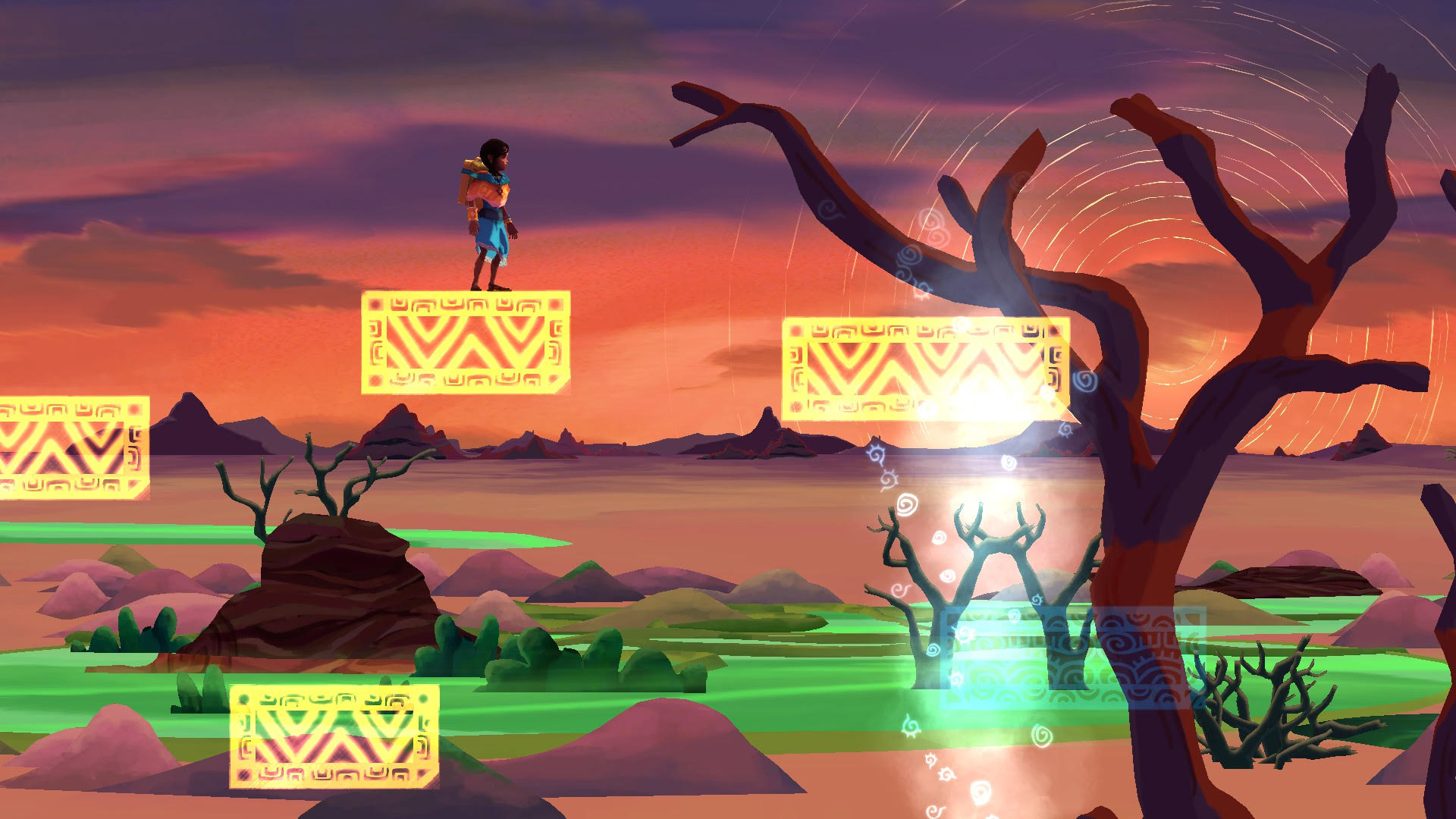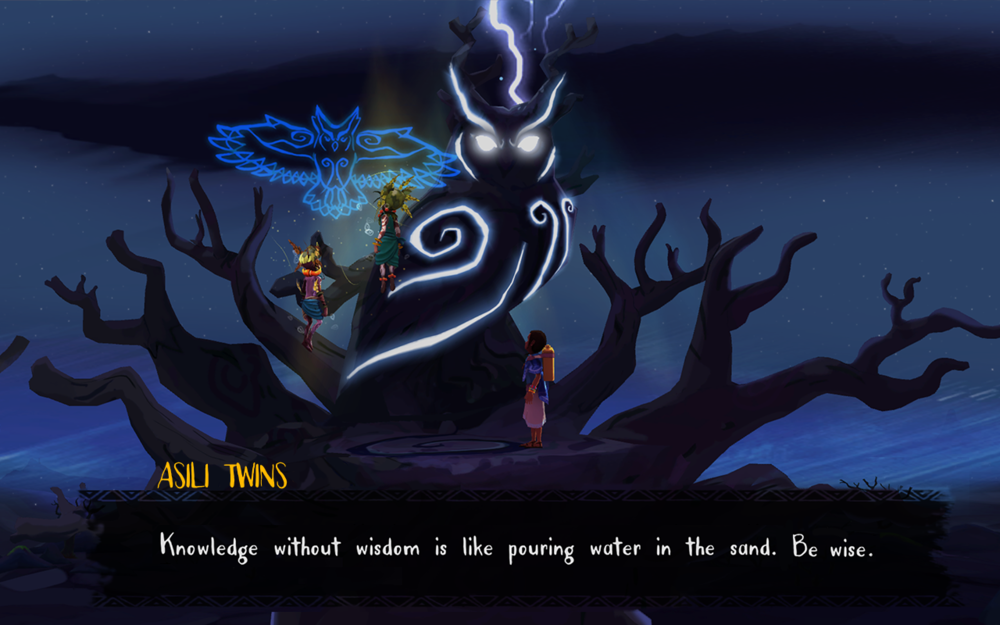Search
[{{{type}}}] {{{reason}}}
{{/data.error.root_cause}}{{{_source.title}}} {{#_source.showPrice}} {{{_source.displayPrice}}} {{/_source.showPrice}}
{{#_source.showLink}} {{/_source.showLink}} {{#_source.showDate}}{{{_source.displayDate}}}
{{/_source.showDate}}{{{_source.description}}}
{{#_source.additionalInfo}}{{#_source.additionalFields}} {{#title}} {{{label}}}: {{{title}}} {{/title}} {{/_source.additionalFields}}
{{/_source.additionalInfo}}- Details
- Category: Computer
- By Hannah Mae
- Hits: 3994
Ayo: A Rain Tale (PC)

Ayo: A Rain Tale
Developed By: Inkline Ltd.
Published By: Inkline Ltd.
Released: November 9, 2017
Available On: Windows, Andriod, iOS, and macOS
Genre: Adventure, Scrolling Platformer, Puzzle
ESRB Rating: None
Number of Players: Single-player
Price: $9.99
Thank you Inkline Ltd. for sending us this game to review!
Sometimes we First World folks don’t know how good we’ve got it. Cars, computers, heaters, lotions - every kind of comfort we need and even what we don’t need are at our fingertips. All the while, there are countless communities who’d consider themselves blessed to have just a half decent source of food. Parents and their children there endure heavy labor just to live. Well, one First World game wishes to pay tribute to one such type of local hero. The kind of hero who braves treacherous miles everyday just to carry forty pounds of water back to their families. This is Ayo: A Rain Tale.
Ayo: A Rain Tale centers around, well, Ayo - a little African girl. Morning has dawned, and it’s time for her to strap on her water pack. The clean water spring is far, but with positive encouragement from her mother and a magic bracelet from her grandfather, Ayo sets off through the burning sands. That doesn’t mean it’s going to be an uneventful trip, though. Strong winds, scorpions, malicious entities, and perilous heat stand between her and providing for her family. I want to give credit to Inkline Ltd. for what they’re trying to do here. Raising awareness for the very real sacrifices many African women and girls make to help sustain their loved ones is a noble intention. However, Ayo’s plot structure was very disjointed. Many story elements go largely unexplained. You don’t know why the bracelet is magical; why there’s some evil storm/spirit/bull that wants to kill you; why there are blue and yellow glowing boxes - Why? Why? Why? I especially don’t understand the presence of those floating, pygmy children. They fly in, spew open-ended lines, bestow abilities, then fly off. You don’t know what they are, what they want, nor why they’re helping Ayo. It made no sense, but that’s not the end of it. The story’s vagueness even undermined their message. Characters tell Ayo to ‘believe’. Believe in what? Believe in herself? Believe in some deity? They want Ayo to put her faith somewhere. I’d like to know where. It all just felt incomplete. That’s a real shame too, because I did see windows of stroytelling brilliance here. Elements rooted in real hardships, like the slow, screen-warbling dangers of sun stroke, were really strong. That was memorable. That was compelling. That reinforced Ayo’s tale because it breeded player empathy. Any attempts to shove some supernatural side to it was just clunky.

Strong Points: Gorgeous Art-style; Identifiable Heroine
Weak Points: Confusing Plot; Unrealized Gameplay
Moral Warnings: Unclear African Spiritualism; Vague Philosophies
Alright, Ayo: A Rain Tale’s tale is about as coherent as toddler scribbles, but a toddler certainly didn’t give it shape and form. This game’s colors just pop! Rich hues were cast across its canvas, creating some welcoming shades that are indeed pleasing to the eye. Hot pinks and lavenders on the briar bushes; light lined indigos for the storm spirit; tribal patterns on Ayo’s clothes; part of me wanted to reach in and touch. It’s also been a while since a game made me stop and enjoy its sunset. The music was fun too with its tribal drums and traditional chants. It didn’t blow me away or anything, but I certainly appreciated it. As for sound design, most onscreen interactions sounded natural, save for a few sound effects like crunching gravel while climbing clouds (try figuring that whole inexplicable-ness out). However, it’s still the visuals that were the most memorable. The one sin these visuals commit, though, is it blurred the lines between tangible objects and the background too well at times. More on that later. Sure, this game grossly pales in comparison to 2012’s hit game, Journey, which also featured a beyond gorgeous desert, but Ayo also applied African styling to its setting, giving it its own unique flavor. Identifiable looks can be worth more than its salt too. If you can’t get high-def, get personality.
As a scrolling platform game, player controls in Ayo followed the tried and true platformer format. Keys ‘A’ and ‘D’ take you left to right with spacebar as your ‘jump’ button. Your journey encourages you onward from the left to the right side of your screen until you reach the end of each story chapter. Now, since a platformer’s fun factor depends so deeply on its controls, input responsiveness is crucial to a satisfying experience. It has to feel fluid and natural to climb rocks or leap gaps. Ayo, I’d say, mostly succeeded. Moving right or left was very on point, saved my bacon on several counts, but the ‘jumping’ part led to some frustration. The problem wasn’t responsiveness, though. Ayo would jump exactly when I told her to. However, her high arc/low distance ratio and sluggish ‘jumping’ animation felt too heavy and difficult to time right. I died many times in quick reaction sequences. That also brings me back to that ‘background props vs. active props’ problem. It’s kind of a big deal. If I can’t tell what I can or cannot stand on, how do the developers expect me not to die? It wasn’t always prevalent, but I grumbled on several occasions for reasons of dying due to leaping at branches that weren’t really there. Thank the Lord this game granted unlimited lives. You do gain extra movement options for Ayo as you progress, but don’t get too excited. They’re mostly passive abilities that activate on their own in set conditions. The ‘X’ key will be added in, though, and the double jump ability is a Godsend once you get it. On a side note, this game does have controller support if that’s what you’d prefer.

Higher is better
(10/10 is perfect)
Game Score - 78%
Gameplay - 15/20
Graphics - 8/10
Sound - 7/10
Stability - 5/5
Controls - 4/5
Morality Score - 90%
Violence - 8.5/10
Language - 10/10
Sexual Content - 10/10
Occult/Supernatural - 6.5/10
Cultural/Moral/Ethical - 10/10
Reaching water in Ayo is gonna take more than a long walk. There’s a puzzle side to its nature, provided by its mechanics. Most hazards kill you on contact. Thus, half of Ayo’s challenge is to avoid typical stuff like briar patches, pitfalls, and bugs. It’s not all that hard to be honest. I hated the lightning though - that inconsistent, may or may not home in, strikes in faster increments, and insta-kill you lightning. That I could do away with. Then there are these yellow and blue glow-ey box things you need to use to progress. (No, I have no idea what to make of them either. Just roll with it.) Both colors can’t be active at the same time, so you must swap them back and forth at opportune moments. This mechanic was trickier to handle, but not in an intellectual sense. Nine times out of ten, I knew exactly what to do after glancing at the boxes layout once. It was the wonky ‘jumping’ controls that made matters difficult. As a result, this whole feature felt ‘tacked on’. Because if I don’t feel like I’ve accomplished something by solving them, then it’s not intrinsically fun. It’s just another slow down I have to slog through. Don’t get me wrong. It wasn’t a deal breaker for me. I guess I just expected something a little more clever from this setup. That doesn’t mean it had to be hard. I just wished the creators took their setting to its fullest potential. Why not have our heroine need to find thick leaves to cover her feet with to travel over a searing hot patch of land? Or to find sharp flint to burn insurmountable brambles with? At least give problems that can be solved by something more engaging or culturally insightful than a ‘jump’.
Spiritual African theming is no surprise in Ayo: A Rain Tale. I don’t know how closely related this game’s pseudo mythology is to actual African beliefs or folktales, but I know a non-Biblical environment when I see one. What appear to be sacred animal statues are used to grant you new abilities. The flying pygmy children and the stormy bull of rampage I’ve already mentioned. Ayo’s bracelet is magical and able to harness the ‘animal powers’ for some unspecified reason, and I’ve already talked about the game’s unfinished philosophy of ‘belief’. As for violence, the game is very tame. Harms that come Ayo’s way either knock her over or lead to a non-bloody death screen, where she simply passes out. That’s it.
Ayo: A Rain Tale is not an unlikable game. Though it didn’t take full advantage of its setting, and the gameplay leaned on the easy side for my tastes, I didn’t consider it a complete waste of time. Not simply because it was lovely to look at, though indeed it is was, but because I wanted to see little Ayo through. She was my in-game motivation to succeed. Sure, she doesn’t speak a word. So, she has no traits that hint to any definable personality at all, but Ayo didn’t need it. She represents the harshness of an impoverished life met head on with hope and bravery out of love for her family. It’s a trait that reflects Christ our Lord and something I can get behind. I just wish the game’s spiritualism didn’t muddy the waters. “Every hardship you face in a positive light is met with positive relief,” the game quotes, but Jesus says in Matthew 11:28, “Come to me, all you who are weary and burdened, and I will give you rest.” Apart from Him, there is no relief.








